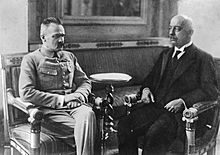Gabriel Narutowicz facts for kids
Quick facts for kids
Gabriel Narutowicz
|
|
|---|---|
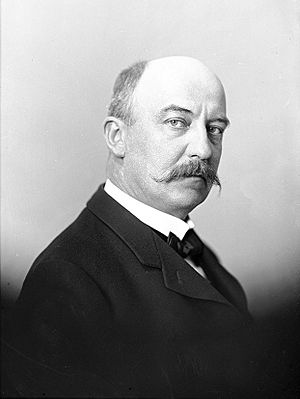
Narutowicz in 1915
|
|
| 1st President of Poland | |
| In office 11 December 1922 – 16 December 1922 |
|
| Prime Minister | Julian Nowak |
| Preceded by | Józef Piłsudski (as Chief of State) |
| Succeeded by | Stanisław Wojciechowski Maciej Rataj (acting) |
| Minister of Foreign Affairs | |
| In office 28 June 1922 – 14 December 1922 |
|
| Prime Minister | Artur Śliwiński Julian Nowak |
| Preceded by | Konstanty Skirmunt |
| Succeeded by | Aleksander Skrzyński |
| Minister of Public Works | |
| In office 28 June 1920 – 6 June 1922 |
|
| Prime Minister | Władysław Grabski Wincenty Witos Antoni Ponikowski |
| Preceded by | Andrzej Kędzior |
| Succeeded by | Władysław Ziemiński |
| Personal details | |
| Born |
Gabriel Józef Narutowicz
29 March 1865 Telsze, Russian Empire (now Lithuania) |
| Died | 16 December 1922 (aged 57) Warsaw, Poland |
| Cause of death | Assassination |
| Political party | None (supported by the Polish People's Party "Wyzwolenie") |
| Spouse | Ewa Krzyżanowska |
| Children | Stanisław, Anna |
| Education | ETH Zurich |
| Profession |
|
Gabriel Józef Narutowicz (born March 29, 1865 – died December 16, 1922) was a Polish engineer and politician. He became the first President of Poland on December 11, 1922. Sadly, he was assassinated just five days later, on December 16.
Before becoming president, Narutowicz was a professor of hydroelectric engineering. He also served as the Minister of Public Works from 1920 to 1922. For a short time in 1922, he was the Minister of Foreign Affairs. Narutowicz was a well-known engineer and was not tied to one political party. He was the first elected head of state after Poland became an independent country again.
Narutowicz was born into a noble family with strong patriotic feelings. He studied in Russia and then in Switzerland. As an engineer, he was a leader in bringing electricity to many places. He also oversaw the building of some of Europe's first hydroelectric power plants. These plants use water to create electricity. In 1907, he became a professor in Zurich. In 1919, he was asked to help rebuild Poland after World War I.
Contents
Who Was Gabriel Narutowicz's Family?
Gabriel Józef Narutowicz came from a Polish-Lithuanian noble family. He was born in Telsze, which was then part of the Russian Empire. This was after Poland had been divided up by other countries.
His father, Jan Narutowicz, was a local judge and landowner. He took part in the January Uprising in 1863 against Russia. Because of this, he was sent to prison for a year. Gabriel's father died when Gabriel was only one year old.
Gabriel's mother, Wiktoria Szczepkowska, raised her sons by herself. She was a well-educated woman who believed in the ideas of the Age of Enlightenment. She greatly influenced Gabriel and his brothers. In 1873, she moved to Liepāja, Latvia. She did this so her children would not have to go to Russian schools. At that time, Russian rule was less strict in Latvia than in Poland and Lithuania.
Gabriel Narutowicz had a brother named Stanisław Narutowicz. After Lithuania became independent in 1918, Stanisław chose to be a Lithuanian citizen. He was a member of the Council of Lithuania, which was like a temporary parliament. He even signed the Lithuanian Act of Independence in 1918.
Gabriel Narutowicz's Early Life and Career (1865–1920)
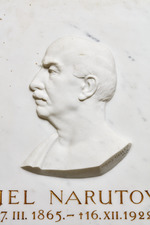
Narutowicz finished high school in Liepāja, Latvia. He then started studying physics and mathematics at the University of St. Petersburg. However, he got sick and had to stop his studies there. He later moved to Zurich Polytechnic in Switzerland, where he studied from 1887 to 1891.
While in Switzerland, Narutowicz helped Polish people who had to leave their homes because of the Russian authorities. He was also involved with a Polish socialist group called "Proletariat". Because of these connections, he was not allowed to return to Russia. In 1895, Narutowicz became a Swiss citizen. After finishing his studies, he worked as an engineer on the St. Gallen railway.
Narutowicz was a very talented engineer. In 1895, he became the chief of works on the River Rhine. His projects were shown at an international exhibition in Paris in 1896. He became famous for his work in bringing electricity to Switzerland. Narutowicz also led the building of many hydroelectric power plants in Europe. Some of these were in Monthey, Mühleberg, and Andelsbuch.
In 1907, he became a professor at ETH Zurich. He was in charge of the water construction institute there from 1913 to 1919. He was also part of the Swiss Committee for Water Economy. In 1915, he was chosen to lead the International Committee for managing the River Rhine.
During World War I, he helped a Swiss committee that was assisting war victims in Poland. He also supported the ideas of Józef Piłsudski, a key figure in Polish history. In September 1919, the Polish government asked Narutowicz to come back to Poland. They wanted him to help rebuild the country's buildings and roads after the war.
Gabriel Narutowicz as a Government Minister (1920–1922)
After returning to Poland, Gabriel Narutowicz became the Minister of Public Works on June 23, 1920. He held this job until June 26, 1922, serving in four different governments. As Minister of Public Works, Narutowicz immediately began rebuilding Poland. He used his experience from Switzerland, where he was a leader in bringing electricity to places. He quickly made the reconstruction department more efficient. He cut the number of employees by three-quarters in two years, which made the work much faster.
Narutowicz often traveled around Poland to personally check on public works projects. By 1921, nearly 270,000 buildings and 300 bridges had been rebuilt. Most roads were fixed, and about 200 kilometers of new highways were added. He also designed dams and oversaw the building of a hydroelectric power plant. This plant was in Porąbka on the river Soła. He also worked on controlling the water flow of the Vistula River.
Politically, he was known as a calm, sensible, and open-minded person. He was part of the government during a time when governments often changed quickly. In April 1922, Narutowicz went to the Genoa Conference. He was praised for the success of the Polish team there. Many foreign diplomats trusted Narutowicz more than other ministers from the newly independent Poland.
On June 28, 1922, he became the Minister of Foreign Affairs. He kept this job in the next government as well. In October 1922, he represented Poland at a meeting in Tallinn. In the 1922 election, he supported a center-right group connected with Józef Piłsudski. He ran for a seat in Parliament but did not win.
How Was Gabriel Narutowicz Elected President?
Even though he lost the parliamentary election, Narutowicz continued as Minister of Foreign Affairs. To his surprise, he was nominated as a candidate for the presidential election in December. Józef Piłsudski tried to convince him not to run. Narutowicz himself first wanted to say no to the nomination. But he eventually agreed to run for president.
According to Poland's March Constitution of Poland, the president had to be chosen by the National Assembly. This assembly included both houses of parliament, the Sejm and the Senate. In the first round of voting, no one won clearly. In the second round, one candidate was eliminated. Still, there was no clear winner. Two more candidates, who were favored by national minorities, then dropped out.
In the final round, only two candidates remained. One was Count Maurycy Zamoyski, supported by a right-wing group. The other was Narutowicz, supported by some center and left-wing parties. He also had the support of groups representing national minorities.
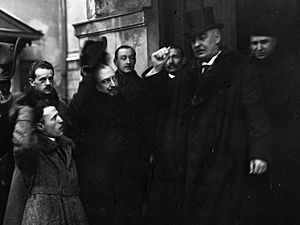
Narutowicz won thanks to votes from the left, national minorities, and a centrist party. This centrist party had first leaned towards Zamoyski but then switched to Narutowicz. In the end, Narutowicz received 289 votes, while Zamoyski got 227 votes. This made Narutowicz the first president of the Second Polish Republic.
Narutowicz's win was a big surprise to many right-wing leaders. After the election, some Catholic and nationalist groups started a strong campaign against him. They called him an atheist and a Freemason. Some newspapers even called him "the Jewish president." Groups against Piłsudski also criticized Narutowicz for supporting Piłsudski's policies.
Gabriel Narutowicz's Presidency and Assassination
Gabriel Narutowicz was president of Poland for only five days. When he took his oath of office on December 11, 1922, some groups protested against him in Warsaw. Earlier that day, people who opposed his election tried to stop him from reaching the Sejm. They blocked streets and threw mud at his car. Narutowicz never felt comfortable with the idea that he was a representative of the Left in Polish politics. He had only become a candidate by chance and had not expected to win.
During his first days as president, Gabriel Narutowicz met with leaders of different political parties. He knew it would be hard to form a government that had a majority in Parliament. So, he tried to create a government that was not tied to one party. To show goodwill to the right wing, he offered his rival, Zamoyski, the job of Minister of Foreign Affairs.
How Did Gabriel Narutowicz Die?
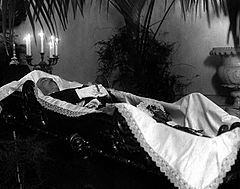
Just five days after becoming president, on December 16, 1922, Narutowicz was assassinated. He was visiting an art exhibit at the National Gallery of Art "Zachęta". The person who killed him was a painter named Eligiusz Niewiadomski. Niewiadomski had connections with a right-wing political party. He was sentenced to death and executed on January 31.
Gabriel Narutowicz in Film
The story of Narutowicz's murder was the main topic of a 1977 Polish movie. It was called Death of a President.
See also
 In Spanish: Gabriel Narutowicz para niños
In Spanish: Gabriel Narutowicz para niños



